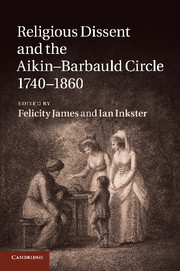Book contents
- Frontmatter
- Contents
- Notes on the editors and contributors
- Foreword
- Acknowledgements
- Chapter 1 Religious Dissent and the Aikin–Barbauld circle, 1740–1860
- Chapter 2 The Revd John Aikin senior
- Chapter 3 How Dissent made Anna Letitia Barbauld, and what she made of Dissent
- Chapter 4 ‘And make thine own Apollo doubly thine’
- Chapter 5 ‘Outline maps of knowledge’
- Chapter 6 ‘Under the eye of the public’
- Chapter 7 ‘The different genius of woman’
- Chapter 8 Lucy Aikin and the legacies of Dissent
- Chapter 9 The Aikin family, retrospectively
- Bibliography
- Index
- References
Chapter 1 - Religious Dissent and the Aikin–Barbauld circle, 1740–1860
an introduction
Published online by Cambridge University Press: 05 November 2011
- Frontmatter
- Contents
- Notes on the editors and contributors
- Foreword
- Acknowledgements
- Chapter 1 Religious Dissent and the Aikin–Barbauld circle, 1740–1860
- Chapter 2 The Revd John Aikin senior
- Chapter 3 How Dissent made Anna Letitia Barbauld, and what she made of Dissent
- Chapter 4 ‘And make thine own Apollo doubly thine’
- Chapter 5 ‘Outline maps of knowledge’
- Chapter 6 ‘Under the eye of the public’
- Chapter 7 ‘The different genius of woman’
- Chapter 8 Lucy Aikin and the legacies of Dissent
- Chapter 9 The Aikin family, retrospectively
- Bibliography
- Index
- References
Summary
We have no portrait of the Aikin family actually en famille, despite their extraordinary achievements and their powerful presentation of themselves as a group. The Edgeworths are famously pictured clustering around a manuscript; Isaac Taylor shows his family joyfully at ease in their garden – but despite the Aikins’ similarities to both these writing dynasties, no image remains of them together. The closest we can come to a group portrait of the Aikin–Barbauld circle is an engraving commissioned for Thomas Macklin’s The Poets’ Gallery, by Francesco Bartolozzi from a drawing by Henry William Bunbury. Macklin intended to commission one hundred paintings illustrating the works of the English poets; this 1791 engraving celebrates ‘The Mouse’s Petition’, by Anna Letitia Barbauld (1743–1825) (see Figure 1).
Barbauld – then Anna Letitia Aikin, before her marriage to Rochemont Barbauld in 1774 – was visiting the theologian and experimental scientist Joseph Priestley in Leeds in 1771 when she wrote the poem, one of her most popular and widely reprinted. It intercedes on behalf of a mouse, ‘found in the trap where he had been confined all night by Dr. Priestley, for the sake of making experiments with different kinds of air’:
Oh! hear a pensive prisoner’s prayer,
For liberty that sighs;
And never let thine heart be shut
Against the wretch’s cries.
In the engraving, a woman – dressed in white, and looking the very picture of sensibility – lectures a sage figure, as he studies the imprisoned mouse, watched by another woman and a child, the whole set in a pastoral glade. The image invites obvious comparison with the figures of the Aikin–Barbauld circle: the woman lecturing evokes Barbauld, and the seated sage, Priestley. The other woman in the picture could well be Joseph Priestley’s wife, Mary, to whom the subsequent verse, ‘To Mrs. P - - - - .; With Some Drawings of Birds and Insects’, in Poems (1773) is dedicated. The little boy who eagerly looks on surely represents Barbauld’s adopted son, Charles Rochemont, the child of her brother John Aikin. Barbauld’s celebrated series of Lessons for Children (1778–9) were written to teach little Charles to read, tracing his development from 2 to 4 years old; countless eighteenth-century and Victorian readers learned along with Charles.
- Type
- Chapter
- Information
- Publisher: Cambridge University PressPrint publication year: 2011



